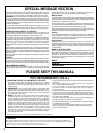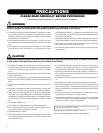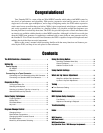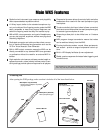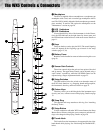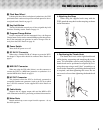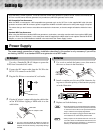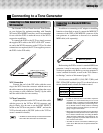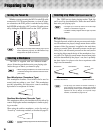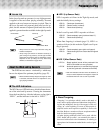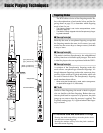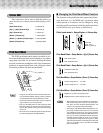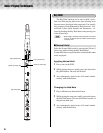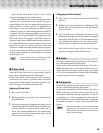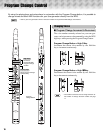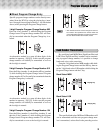
10
Preparing to Play
Turning the Power On
Whether you are powering the WX5 via the WX cable
connected to a VL70-m tone generator, or via an AC adap-
tor or batteries, the WX5 power is switched on by sliding
the POWER switch to the “ON” position. Turn the power
off by sliding the POWER switch to the “OFF” position.
• Depending on the setup switch settings (page 10) and
sensor adjustment (page 25), the LED indicators may
not light when the power is turned on.
MIDI OUT
WX OUT
POWER
OFF
+ –
ON DC IN 12V
Selecting a Mouthpiece
The WX5 is supplied with two different mouth-
pieces. Select the type that best suits your playing style
and/or the type of music you intend to play.
• When changing mouthpieces, be careful not to bend
or otherwise damage the cantilever inside the mouth-
piece cavity.
Reed Mouthpiece (Saxophone Type)
This mouthpiece features a reed which can be used to
control pitch according to your “bite”. This mouthpiece
provides playability and expressive control essentially
equivalent to a saxophone or clarinet.
Reedless Mouthpiece (Recorder Type)
This mouthpiece has no reed and thus does not allow lip
control. Playing the reedless mouthpiece is similar to play-
ing a recorder.
When using the reedless mouthpiece, set the lip mode to
“Loose Lip” via the setup switches, as described on page 22.
• The WX5 is initially shipped with the Reed Mouthpiece
attached.
Selecting a Lip Mode: Tight Lip or Loose Lip
The WX5 has two basic playing modes: Tight Lip
and Loose Lip, described below. Select the mode which
best suits your playing style.
• The Tight Lip or Loose Lip mode is set via the setup
switches, as described on page 22.
• The WX5 is initially shipped with the Tight Lip mode
selected.
■ Tight Lip
The tight lip mode, which is the way most acoustic single-
reed instruments are played, simply means that a certain
amount of bite (lip pressure) is applied to the reed when
playing at normal pitch. Increased pressure on the reed
raises pitch, and decreased pressure on the reed (and/or
moving the bite towards the tip of the mouthpiece) low-
ers pitch. The Tight Lip mode means that accurate pitch
must be determined by the player’s ear, but is probably
the best choice for players who have experience with
single-reed instruments.
Bend Down Normal Pitch Bend Up
Upward Pitch Bend
Downward Pitch Bend
• The lip range (the amount of variation caused by a
given change in lip- pressure), and the type of effect
produced by lip pressure (pitch or modulation) can be
adjusted via the Lip Range and Lip Data setup
switches, as described on page 22, 23.



